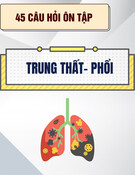
HUE JOURNAL OF MEDICINE AND PHARMACY ISSN 3030-4318; eISSN: 3030-4326
76
Hue Journal of Medicine and Pharmacy, Volume 14, No.6/2024
Microscopic characteristics, total phenolic content and antioxidant
activity of Zingiber nudicarpum
Nguyen Dinh Quynh Phu1*, Doan Quoc Tuan1, Huynh Van Quynh1
(1) Hue University of Medicine and Pharmacy, Hue University
Abstract
Background: Zingiber Mill. is one of the most diverse genera in Vietnam with 36 recorded species,
many of which have been used as traditional medicine to treat several ailments. Reports of studies on Z.
nudicarpum D. Fang are relatively scarce. Objectives: This study aimed to determine the microscopic
characteristics, total phenolic content and antioxidant activity of Z. nudicarpum. Materials and methods: Z.
nudicarpum was collected in Phong Dien district, Thua Thien Hue province. Anatomic features and powder
characteristics were determined by the microscopic methods. The Folin-Ciocalteau method and 2,2-Diphenyl-
1-picrylhydrazyl (DPPH) assay were used to analysis the total phenolic content (TPC) and antioxidant
potential, respectively. Results: The microscopic characteristics of the leaves and roots of Z. nudicarpum
have been reported. The ethanol extract from the aerial part of Z. nudicarpum exhibited a notable amount
of phenolic content and antioxidant activity than the underground part extract. The total phenolic content in
the aerial and underground parts extract were 373.41 ± 1.50 mg GAE/g extract and 61.27 ± 1.65 mg GAE/g
extract, respectively. The highest DPPH radical scavenging effect was observed in the aerial part with IC50
value of 4.86 ± 0.08 µg/mL, while it was not found in the extract from the underground part (IC50 > 500 µg/
mL). Conclusion: This is the first report on the microscopic features, total phenolic content and antioxidant
capacity of Z. nudicarpum.
Keywords: Zingiber nudicarpum, microscopic characteristics, phenolic, DPPH.
Corresponding Author: Nguyen Dinh Quynh Phu. Email: ndqphu@huemed-univ.edu.vn
Received: 20/3/2024; Accepted: 10/10/2024; Published: 25/12/2024
DOI: 10.34071/jmp.2024.6.11
1. BACKGROUND
Zingiber Mill. is the third largest genus of the
Zingiberaceae family with over 140 species that are
extensively distributed in Asia, South America and
Africa. In particular, Southern China and the Indochina
peninsula are considered representative biodiversity
centers for this genus. Species in the Zingiber genus
have been used for ethnomedicine, food, and spices
in many countries. Recent research has identified a
wide variety of chemical components from Zingiber
plants, including volatile oils, organic acids, flavonoids,
terpenoids, etc… Modern pharmacological studies
have demonstrated that they possessed enormous
pharmacological applications such as antimicrobial,
antioxidant, anti-obesity, anti-inflammatory,
hypoglycemic, neuroprotective, cardiovascular
protective and anti-tumor effects [1].
There are currently at least 36 species of Zingiber
known to exist in Vietnam. Numerous species in this
genus have been widely used as medicinal plants
in folk and traditional medicine, as spices, and as a
source of raw material for the extraction of essential
oil [2]. Z. nudicarpum D. Fang has been considered
an endemic species in southern China. Recently, this
species was discovered in central Vietnam and has
been added to Vietnam’s flora. Z. nudicarpum has
been found in Nghe An, Quang Binh, Thua Thien Hue,
Quang Nam and Quang Ngai provinces [3]. Literature
review showed that studies on this plant mostly
focused on the chemical composition of essential
oil [4]. In this study, the microscopic characteristics,
total phenolic content and DPPH radical scavenging
effect Z. nudicarpum were investigated.
2. MATERIALS AND METHODS
2.1. Materials
The plant of Zingiber nudicarpum D. Fang
(Zingiberaceae) (Figure 1) was collected in Phong
Dien district, Thua Thien Hue province in July 2023
and identified by Dr. Anh Tuan Le (Mientrung Institute
for Scientific Research, Vietnam National Museum of
Nature, VAST, Vietnam). Voucher specimen (PD-02)
has been deposited at the Faculty of Pharmacy, Hue
University of Medicine and Pharmacy, Vietnam.






























